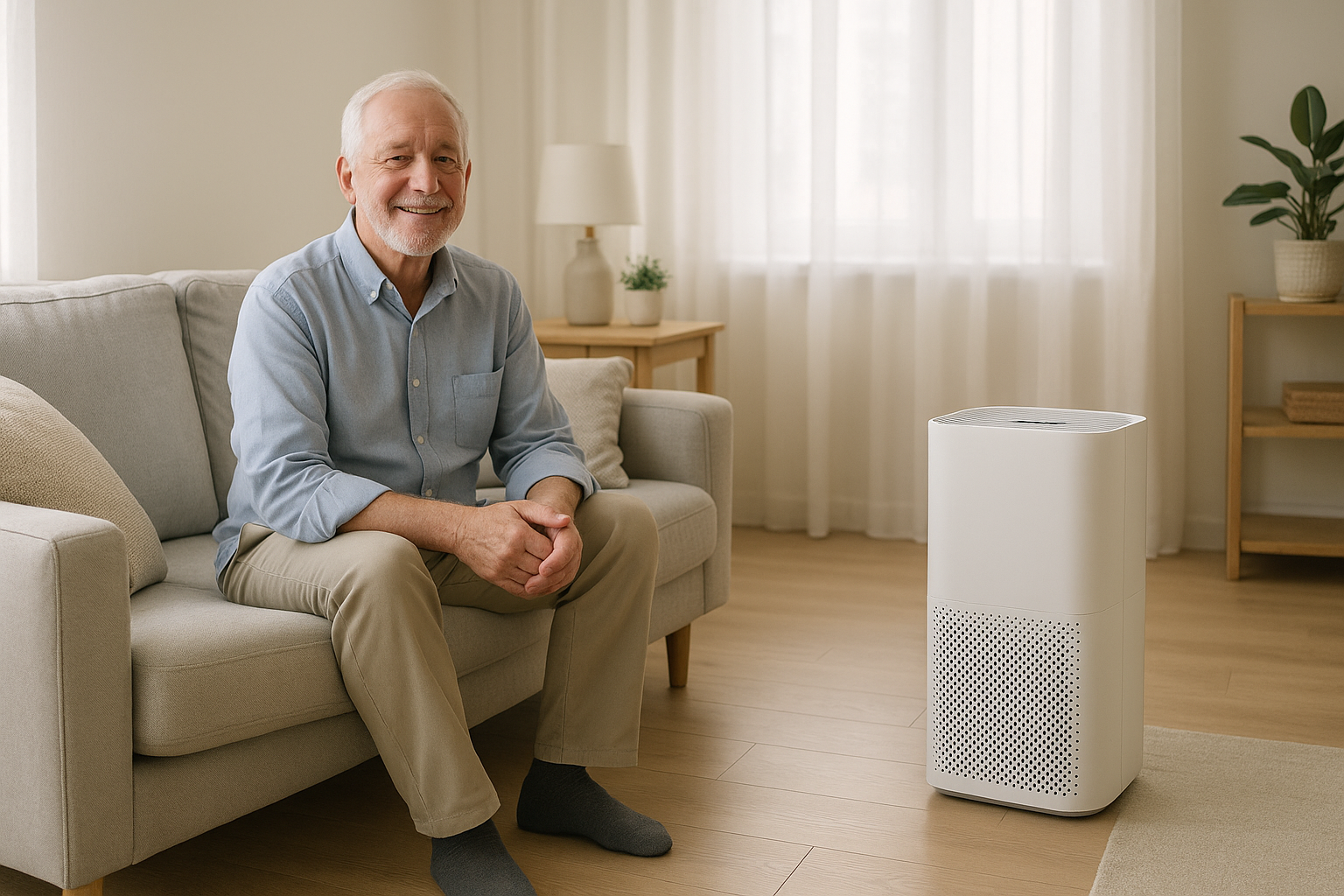HEPA air purifiers can greatly improve indoor air quality for individuals with COPD, reducing pollutants like dust, mold, and pet dander that worsen symptoms. Selecting the right purifier depends on room size, Clean Air Delivery Rate (CADR), and specific features like noise levels and filter types. This guide highlights the top 10 models, explaining their performance, room coverage, and suitability for COPD management.
Key Takeaways:
- Room Size Matters: Match the purifier's capacity to the room size for optimal air cleaning. Larger spaces may need higher CADR ratings or multiple units.
- CADR Ratings: Higher CADR means faster air purification. Aim for at least 4–5 air changes per hour for effective results.
- True HEPA Filters: Essential for removing 99.97% of airborne particles, including those as small as 0.3 microns.
- Noise Levels and Maintenance: Look for quiet models and consider filter replacement costs for long-term use.
- Avoid Ozone Generators: These can worsen COPD symptoms.
Quick Overview of Top Models:
- Levoit Core 400S: Best for medium rooms (up to 403 sq ft), smart features, and quiet operation.
- Honeywell HPA300: Ideal for large rooms (up to 465 sq ft), with high CADR ratings and simple controls.
- Coway Airmega 400: Covers up to 1,560 sq ft, with dual HEPA filters and excellent air cleaning capacity.
- Winix 5500-2: Affordable, effective for medium rooms (up to 360 sq ft), and includes PlasmaWave technology.
- Dyson Purifier Cool TP07: Combines air purification with a fan, suitable for smaller spaces (up to 141 sq ft).
- **Blueair Blue Pure 211+: Handles large areas (up to 540 sq ft) with washable pre-filters and energy efficiency.
- Medify MA-40: Covers up to 840 sq ft with medical-grade filters, great for medium to large spaces.
- Rabbit Air MinusA2: Customizable filters, wall-mountable, and suitable for rooms up to 815 sq ft.
- Alen BreatheSmart 75i: Designed for large spaces (up to 1,400 sq ft), with smart sensors and multiple filter options.
- GermGuardian AC9200WCA: Covers larger rooms (up to 1,620 sq ft), with UV-C light for added germ protection.
Choosing the right purifier can reduce COPD symptoms, improve lung function, and enhance overall comfort. Read on for detailed reviews and a comparison of these top models.
Can an Air Purifier Help You Breathe Better? | COPD Care Collective

How Air Quality Affects COPD Symptoms
When it comes to COPD, poor indoor air quality is more than just an inconvenience - it’s a direct trigger for worsening symptoms. For individuals with COPD, breathing in polluted air places additional stress on their already vulnerable lungs. This can lead to increased inflammation, reduced lung function, and more frequent flare-ups, making day-to-day life even more challenging [1].
Here’s how it works: fine particles and gases in the air irritate the lungs, prompting the body to overproduce mucus. This results in persistent coughing, chest tightness, and a worsening of shortness of breath [8]. For the 16 million Americans living with COPD, these symptoms are a constant battle [8]. Unfortunately, many common indoor pollutants are major contributors to this issue.
Common Indoor Air Pollutants That Worsen COPD
Everyday household pollutants can be particularly harmful to people with COPD. Dust, tobacco smoke, diesel emissions, combustion exhaust, pollen, pet dander, and mold spores are some of the most problematic irritants [1]. Each of these can independently trigger symptoms, but together, they create an even more toxic environment. Alarmingly, household air pollution plays a role in 20–25% of COPD cases among individuals who have never smoked [2].
"Indoor air quality is critical to everyone's health, especially people living with chronic obstructive pulmonary disease (COPD)." - Editorial Staff, American Lung Association [1]
Understanding the dangers of indoor pollutants helps highlight the broader global impact of air quality on COPD.
The Scale of the Problem
Globally, air pollution significantly contributes to COPD-related deaths and complications [2][7][8].
How HEPA Air Purifiers Make a Difference
Given these risks, improving indoor air quality is essential - and HEPA air purifiers offer a practical solution. These devices are designed to remove 99.97% of particulate matter, including PM2.5, smog, and bacteria, with particles as small as 0.3 μm [9]. Scientific evidence supports their effectiveness. Randomized clinical trials and meta-analyses have shown that HEPA and carbon filter air cleaners can reduce indoor PM2.5 levels by 61% and lower NO2 concentrations by 4% over six months in homes of former smokers with COPD [9].
The Beijing Indoor Air Purifier Study (BIAPSY) further underscores this. Participants using active filtration saw a dramatic drop in PM2.5 levels, with ten-day averages falling from 60 ± 45 μg/m³ to 24 ± 15 μg/m³ [9]. Additionally, the study observed a 58.59% reduction in interleukin-8 (IL-8) levels, a key marker of inflammation, when active filtration was used compared to sham filtration [9]. These improvements directly translate to fewer COPD symptoms and better respiratory health.
Beyond Respiratory Benefits
HEPA air purifiers don’t just improve breathing - they also offer broader health advantages. Research shows they can lower levels of inflammatory markers linked to cardiovascular disease, which is especially important for COPD patients who face higher cardiovascular risks [9][11].
Dr. Meredith McCormack from Johns Hopkins highlights these wider implications:
"These particles and other indoor air pollutants can cause systemic inflammation in susceptible patients, like those with COPD. Our study shows there's a negative impact on cardiovascular health, as well." [5]
The takeaway is clear: poor indoor air quality exacerbates COPD symptoms by increasing inflammation and irritation. HEPA air purifiers provide a proven way to tackle these pollutants, improving both respiratory and overall health outcomes.
HEPA Filters and CADR Ratings Explained
HEPA filters and CADR ratings play a crucial role in determining how effectively an air purifier cleans indoor air - a key factor in managing COPD.
What Makes HEPA Filters Stand Out
HEPA, short for "high-efficiency particulate air filter", refers to a pleated mechanical filter capable of removing at least 99.97% of dust, pollen, mold, bacteria, and airborne particles as small as 0.3 microns [4]. Interestingly, 0.3 microns is considered the most penetrating particle size (MPPS), meaning particles larger or smaller are captured with even greater efficiency. This level of filtration can significantly reduce lung irritation for COPD patients. Some HEPA filters go even further, eliminating over 99% of airborne pollutants in your home [3].
Breaking Down CADR Ratings
CADR, or Clean Air Delivery Rate, measures how much filtered air (in cubic feet per minute or CFM) an air purifier delivers. Essentially, it reflects how quickly the device can clean a room's air [13]. This rating, overseen by the Association of Home Appliance Manufacturers (AHAM), combines both the unit’s airflow and the filter’s efficiency. For example, if a purifier has an airflow of 200 CFM and operates at 100% efficiency, its CADR would be 200. If the efficiency drops to 75%, the CADR falls to 150.
CADR ratings are provided for three particle types - smoke, pollen, and dust - with maximum values around 450 for smoke and pollen and 400 for dust [13]. Starting in 2024, a new PM2.5 CADR metric will also measure performance for particles smaller than 2.5 microns [12]. To maximize air purification, match the CADR rating to your room size.
Matching CADR to Room Size
To ensure optimal air cleaning, the air purifier’s CADR should correspond to the size of your room. CADR is tied to how many times the air in a room is completely filtered per hour, a metric known as Air Changes per Hour (ACH). Experts generally recommend five ACH for maintaining good indoor air quality [13].
One simple rule is the "2/3's rule": multiply your room's square footage by two-thirds to find the minimum CADR required. Here's a handy table:
| Room Size (sq ft) | Minimum CADR Needed | Recommended CADR for COPD |
|---|---|---|
| 200 | 133 CFM | 175+ CFM |
| 300 | 200 CFM | 250+ CFM |
| 400 | 267 CFM | 325+ CFM |
| 500 | 333 CFM | 400+ CFM |
If your room has ceilings taller than eight feet, you’ll need to increase the CADR to account for the additional air volume [13]. Opting for a unit with a higher CADR than the minimum can also allow you to run it at quieter, lower speeds while maintaining effective air cleaning [14]. This is especially helpful for COPD patients who may need continuous air purification.
Key Considerations for COPD Patients
It’s important to note that CADR ratings are based on the air purifier running at its highest fan speed with a brand-new filter [12]. Over time, as the filter collects particles, its efficiency will decline. Regular maintenance and timely filter replacements are essential to maintain performance.
While CADR provides a clear measure of air cleaning capability, it doesn’t account for other factors like noise levels, ozone emissions, motor durability, or energy consumption. These aspects are worth considering, especially if you plan to run the purifier continuously. For COPD patients, balancing high performance with comfort and practicality is key.
What to Look for in a HEPA Air Purifier for COPD
When managing COPD, choosing the right air purifier can make a big difference in protecting your respiratory health. Indoor air tends to contain much higher levels of pollutants compared to outdoor air[19], so selecting a device capable of effectively removing harmful particles is crucial.
True HEPA Filtration: A Must-Have
A True HEPA filter is non-negotiable for quality air purification. These filters are designed to capture 99.97% of particles as tiny as 0.3 microns, including dust, pollen, pet dander, bacteria, and even some viruses[15]. Be cautious of "HEPA-type" filters, as they don't meet the same rigorous standards and may not provide adequate protection.
Activated Carbon for Odor and VOC Removal
Activated carbon filters are particularly useful if you're dealing with odors or volatile organic compounds (VOCs) that can irritate sensitive airways. This feature is especially important in households with smokers, where pollutant levels are higher[3]. When paired with a True HEPA filter, activated carbon ensures a more thorough cleaning of your indoor air, which is essential for managing COPD symptoms.
Match CADR to Your Room Size
The Clean Air Delivery Rate (CADR) indicates how quickly an air purifier can filter air in a given space. To get the best results, choose a purifier with a CADR that matches the size of the room where it will be used. A higher CADR means faster and more efficient air cleaning, which is particularly important for those with respiratory conditions. Using an undersized purifier in a large space won’t provide sufficient filtration, while an oversized unit in a small room may create unnecessary noise. For larger areas, you might want to invest in multiple units.
Noise Levels for Comfortable Use
If you plan to run your purifier continuously, pay attention to its noise level. Look for models that operate below 55 decibels[16]. Some devices have small, noisy motors that can disrupt sleep or daily activities, so it’s a good idea to test a unit’s noise output before purchasing. If you only have one purifier, placing it in your bedroom - where you spend the most time - can maximize its benefits[17].
Energy Efficiency for Round-the-Clock Operation
Air purifiers for COPD often need to run 24/7, making energy efficiency an important consideration. Opt for Energy Star-rated models, which provide effective air cleaning while consuming less power. This helps keep your energy bills manageable while ensuring continuous operation[3].
Steer Clear of Ozone-Generating Devices
Avoid devices that produce ozone, such as ozone generators, ionizers, or ion generators. Ozone is a lung irritant that can worsen COPD symptoms, trigger asthma attacks, and even harm healthy lungs[19]. According to the American Lung Association, these technologies - ironically marketed to improve air quality - can actually contribute to indoor air pollution.
Keep Up with Maintenance
Regular maintenance is essential to keep your air purifier running effectively. Replace filters every 6–12 months and clean the unit monthly[18]. When shopping for a purifier, don’t forget to factor in the cost of replacement filters to ensure it fits your budget.
Research from UMMS Health highlights the benefits of portable high-efficiency air cleaners, noting that they significantly reduce breathlessness, coughing, and the need for rescue medications in COPD patients[17]. Keeping these features in mind will help you select a purifier that supports your respiratory health and provides long-term relief.
1. Levoit Core 400S
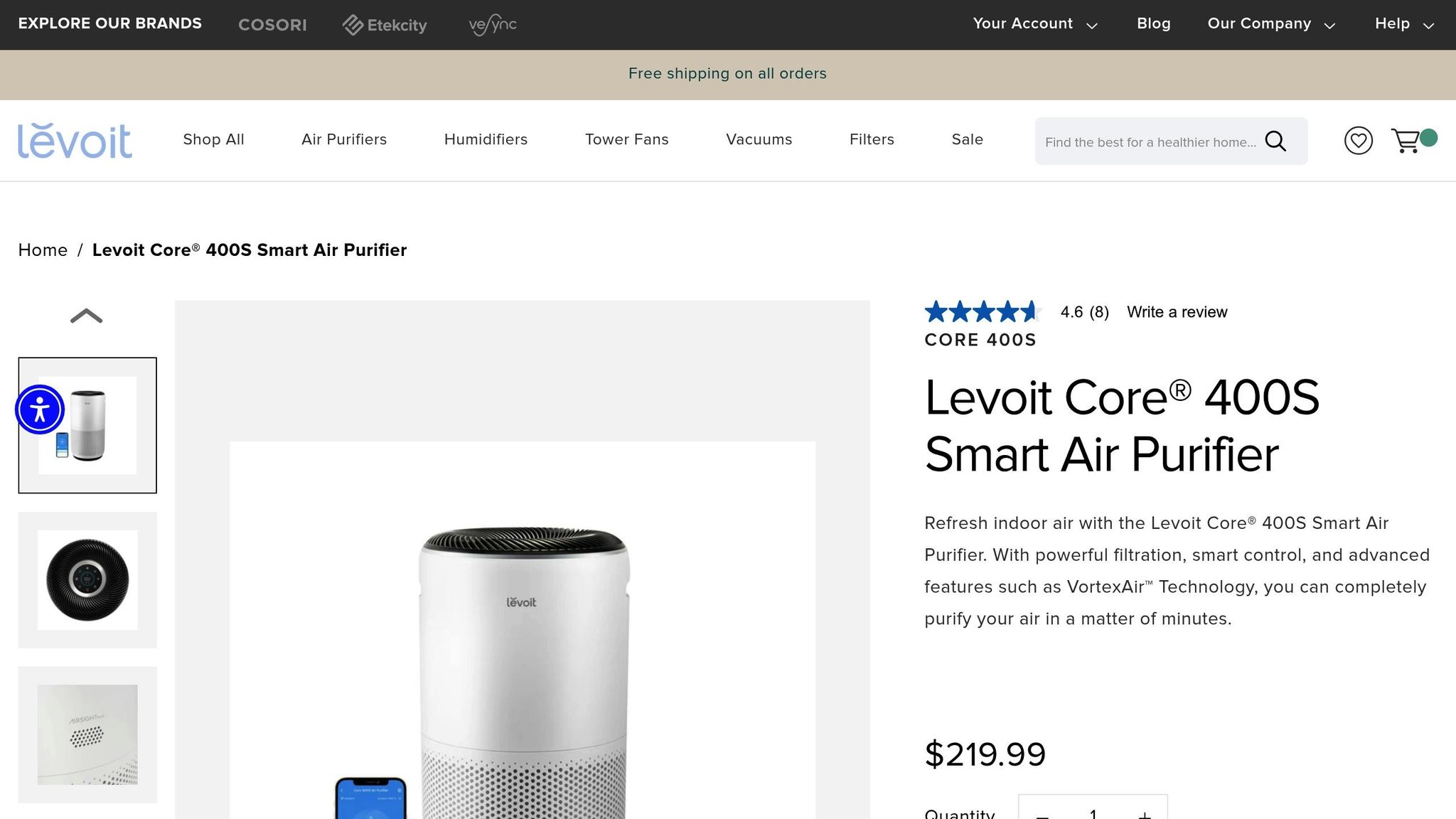
The Levoit Core 400S is a smart air purifier designed to meet the needs of COPD patients in medium-sized rooms. It combines efficient filtration with modern conveniences like smart controls, an auto-mode feature, and a real-time air quality display. This blend of advanced functionality and reliable performance makes it a strong choice for anyone looking to improve their indoor air quality.
"A solid option to consider with medium-sized rooms and those who value smart features like app support, auto-mode, and a screen that displays air quality levels in real time." - Danny Ashton, HouseFresh Founder & Lead Tester[21]
With over 21,000 Amazon reviews averaging 4.7 out of 5 stars and a 9.6/10 performance rating from Air Purifier First[20], the Core 400S has earned high praise. Users frequently highlight its ability to improve air quality, reduce odors, and operate quietly. The app's user-friendly design is another feature that has won over many customers.
Room Size Compatibility
The Core 400S is tailored for medium-sized spaces, offering optimal performance in rooms up to 403 square feet, where it refreshes the air 4.8 times per hour[20]. This makes it ideal for areas like living rooms, bedrooms, kitchens, and home offices.
Its performance has been tested in various room sizes, showcasing impressive results. For example, in a 320 sq ft room, it reduced PM2.5 levels from 101.7 to 4.5 µg/m³ (a 96% improvement). In a larger 560 sq ft room, it brought PM2.5 levels down from 108.2 to 10.1 µg/m³ (a 91% improvement)[20].
For the best results, run the unit at full speed for about 20 minutes to quickly establish clean air levels, then switch to auto mode to maintain air quality.
CADR Ratings
The Core 400S delivers strong Clean Air Delivery Rate (CADR) ratings across the pollutants that matter most to COPD patients:
- Smoke: 231 CFM
- Dust: 240 CFM
- Pollen: 259 CFM[22]
These numbers mean the purifier can clean air in spaces up to 1,733 square feet in one hour[22]. However, to ensure the best air quality for COPD management, using it in the recommended 403 square foot range allows for multiple air changes per hour, providing consistent and thorough purification.
Filter Types
This model features a 3-stage filtration system designed to capture a wide range of airborne irritants that can aggravate COPD symptoms. The system includes:
- A pre-filter to trap larger particles like dust and pet hair.
- A True HEPA filter, which removes 99.99% of bacteria and viruses with statically charged fibers[23].
- An activated carbon filter to neutralize odors and harmful gases.
For those needing extra odor control, Levoit offers specialized filter options. The original filter includes 240g of activated carbon, while the Pet Allergy and Toxin Absorber filters contain 400g, and the Smoke Remover filter provides 450g of carbon[21].
Replacement filters cost between $50 and $60 and need to be replaced annually[23].
Noise Level
The Core 400S is designed to operate quietly, especially in auto mode, which makes it a great choice for bedrooms or other quiet spaces. Customers frequently mention its low noise levels, ensuring it can run continuously without disturbing sleep or daily activities[22].
With its combination of smart features, reliable filtration, and quiet operation, the Core 400S stands out as an excellent option for COPD patients seeking cleaner air and a healthier home environment.
2. Honeywell HPA300
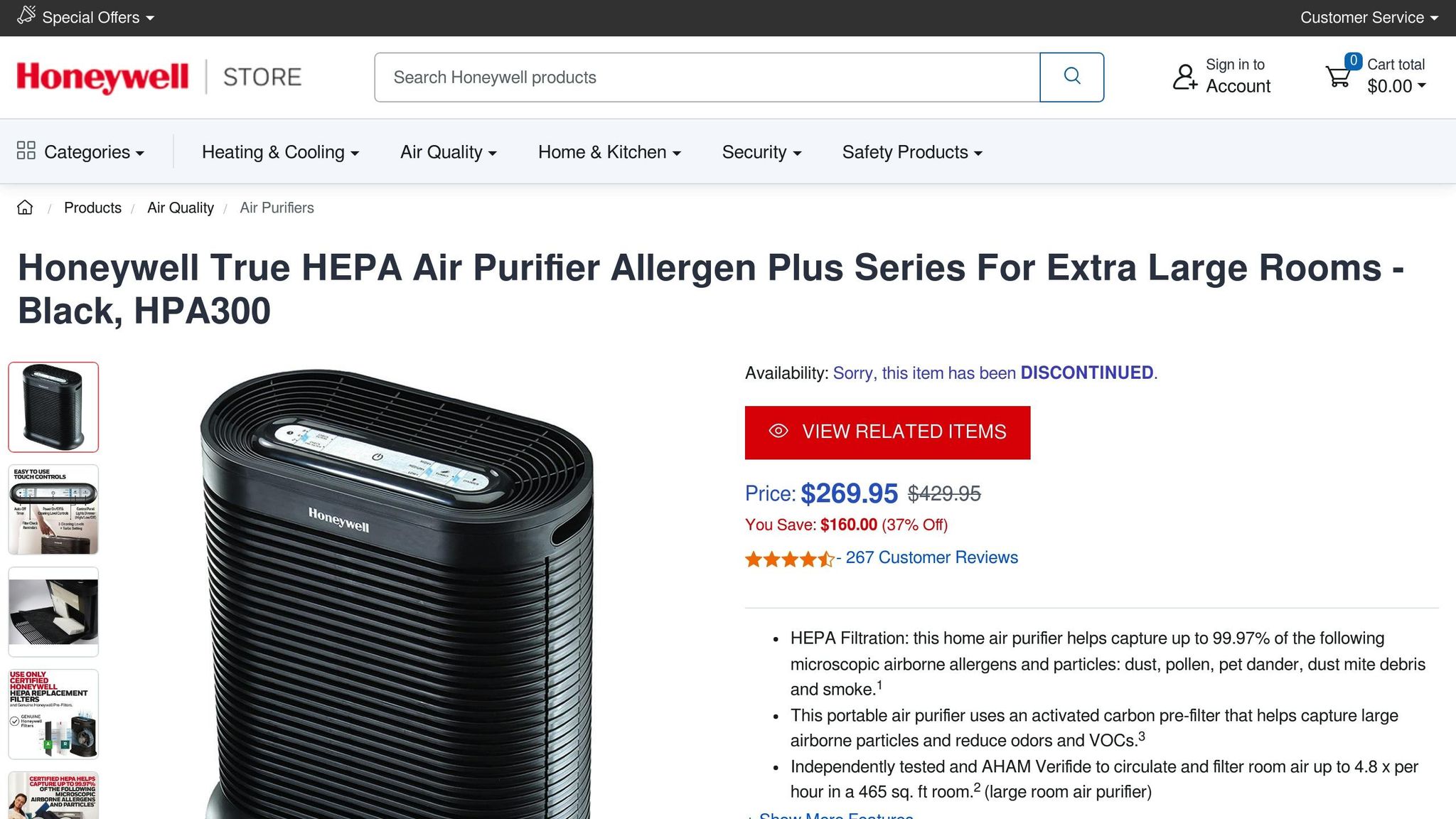
The Honeywell HPA300 is a reliable air purifier designed for large rooms, making it a practical choice for COPD patients who need consistent air cleaning without the distraction of advanced tech features. With over 32,480 reviews on Amazon and an impressive 4.6 out of 5-star rating[25], it has earned its place as a trusted option for improving respiratory health.
"The Honeywell HPA300 is a no-thrills, hard-working air purifier for those on a budget." - Danny Ashton, Founder & Senior Writer[26]
This model focuses on what matters most: performance. While it skips app connectivity and real-time air quality displays, it delivers the kind of filtration that many COPD patients depend on to breathe easier. Let’s break down its key features, including room coverage, CADR ratings, filtration system, and noise levels.
Room Size Compatibility
Designed with large spaces in mind, the HPA300 is perfect for areas where maintaining air quality is critical. It effectively purifies rooms up to 465 sq ft with 4.8 air changes per hour and can handle up to 2,250 sq ft in just 60 minutes[24][25]. This makes it a great option for larger homes or open layouts, reducing the need for multiple units.
CADR Ratings
The HPA300 boasts impressive Clean Air Delivery Rate (CADR) ratings, which measure its ability to filter out specific pollutants:
| Pollutant | CADR Rating (CFM) |
|---|---|
| Smoke | 300 |
| Dust | 320 |
| Pollen | 300 |
The standout here is the 320 CFM rating for dust, a common irritant for COPD sufferers. This ensures that the purifier can handle one of the most challenging triggers effectively.
Filter Types
The HPA300 uses a two-stage filtration system to tackle airborne pollutants:
- True HEPA Filter: Captures 99.97% of microscopic allergens and particles as small as 0.3 microns[27]. This level of efficiency is essential for trapping fine particles that can exacerbate COPD symptoms.
- Activated Carbon Pre-Filter: Reduces odors and volatile organic compounds (VOCs) while also capturing larger particles. This pre-filter not only improves air quality but also extends the lifespan of the HEPA filter[27].
For optimal performance, replace the HEPA filter once a year and the pre-filter every three months using genuine Honeywell replacements.
Noise Level
Users generally find the HPA300 quiet on its lower speed settings, making it suitable for nighttime use. However, higher speeds can be noisy, which may be a consideration for some. That said, the benefits of improved air quality often outweigh the occasional noise, especially when used on lower settings during sleep[25].
3. Coway Airmega 400
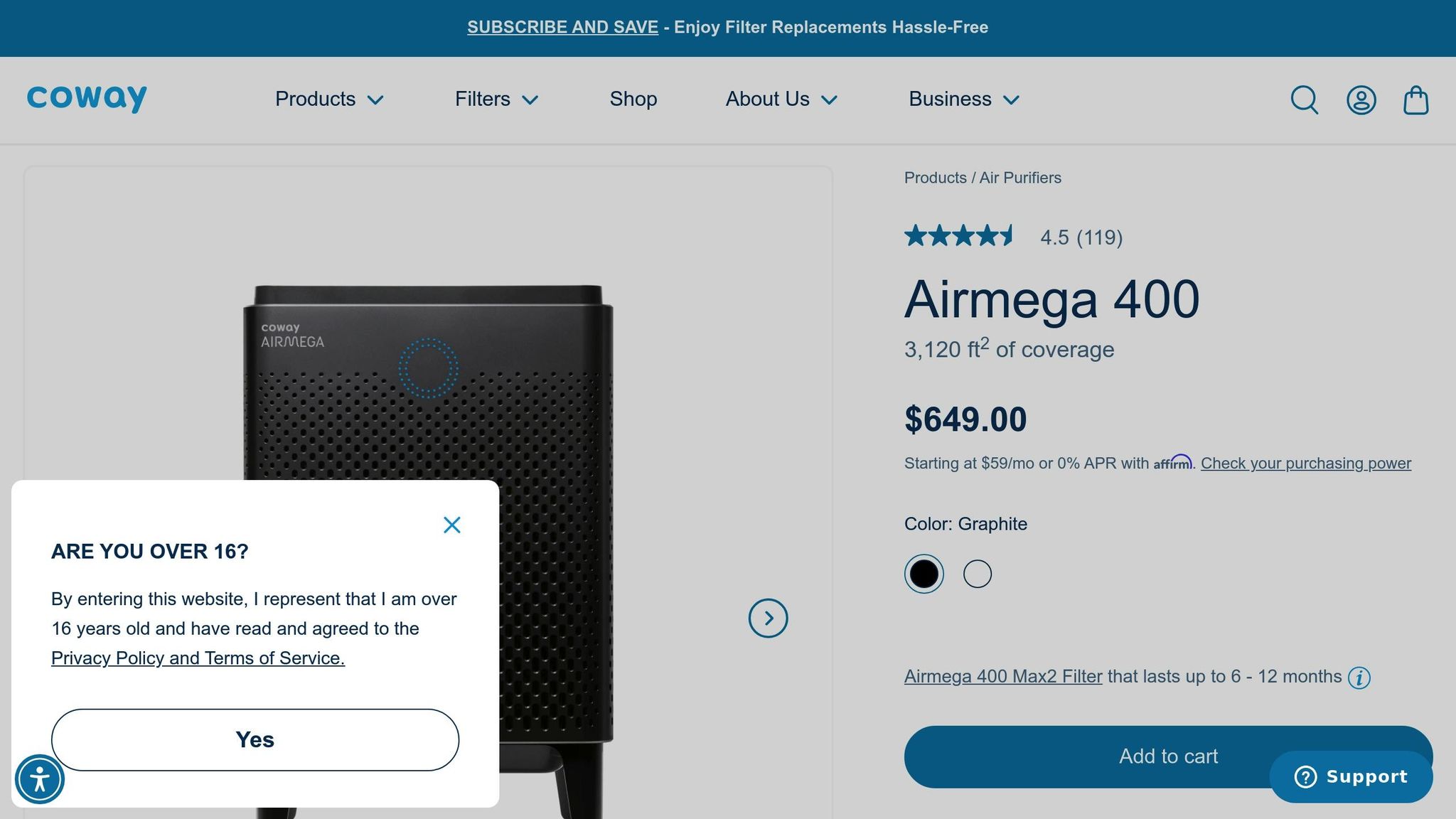
The Coway Airmega 400 is built for large spaces and stands out as a solid choice for those managing COPD. Featuring a three-stage filtration system, it works quickly to eliminate pollutants that can aggravate symptoms. With some of the highest CADR ratings in its category, this unit ensures that harmful particles are efficiently removed. Let’s break down the features that make it a great option for COPD patients.
Room Size Compatibility
The Airmega 400 is designed to handle large areas with ease. It can filter the air in spaces up to 1,560 square feet, achieving two air changes per hour [29][30]. For even larger spaces - up to 3,120 square feet - it can perform one complete air change per hour [30]. This broad coverage makes it ideal for open layouts, spacious living rooms, or master bedrooms where COPD patients often spend most of their time.
CADR Ratings
When it comes to Clean Air Delivery Rate (CADR), the Airmega 400 performs impressively across the board:
| Pollutant | CADR Rating (CFM) |
|---|---|
| Smoke | 328 |
| Dust | 328 |
| Pollen | 400 |
The 400 CFM rating for pollen is particularly noteworthy, making it highly effective against allergens. Meanwhile, the consistent 328 CFM ratings for smoke and dust ensure dependable protection against fine particles that might irritate sensitive lungs.
Filter System
The Airmega 400 uses a robust three-stage filtration system to tackle a wide range of airborne contaminants:
- Washable Pre-Filter: Traps larger particles like dust and pet hair, helping to extend the life of the other filters [28].
- Activated Carbon Filter: Absorbs odors and volatile organic compounds (VOCs), which can irritate the respiratory system [28].
- Green True HEPA™ Filter: Captures 99.97% of ultra-fine particles, including viruses, bacteria, fungi, and pollen. It also features an antimicrobial treatment to reduce the spread of harmful contaminants [28].
Adding to this is the HyperCaptive™ Filtration Technology, which captures 99.999% of particles as small as 0.01 microns [28]. This advanced filtration makes it especially useful for COPD patients who need quick and thorough removal of airborne irritants.
In laboratory testing (Biosafety Level 3), the Airmega 400 demonstrated its efficiency by removing over 99.98% of SARS-CoV-2 aerosol particles within just two minutes on its highest speed setting [31]. For maintenance, the Max2 filter set should be replaced approximately every 12 months (around $129.00), while the washable pre-filter should be cleaned regularly. A built-in filter replacement indicator will alert you when it’s time for upkeep [28].
Noise Level
The Airmega 400 operates quietly, with noise levels ranging from 22 to 52 dB(A) [28]. At its lowest setting, it’s barely noticeable, making it a great choice for nighttime use in bedrooms. Even at higher speeds, the noise remains manageable, ensuring a peaceful indoor environment.
4. Winix 5500-2
The Winix 5500-2 strikes a balance between affordability and performance, making it a reliable choice for COPD patients in need of effective air purification. Designed for medium-sized spaces, this air purifier combines powerful filtration with user-friendly features. With over 28,000 reviews and a 4.6-star rating on Amazon, it's clear that many users trust this device to improve their indoor air quality [34].
Room Size Compatibility
This unit is best suited for rooms up to 360 square feet, where it can refresh the air nearly five times per hour [32]. It's a great fit for medium-sized bedrooms, family rooms, or home offices. During testing, the Winix 5500-2 improved air quality by 96% in a 320-square-foot room within just 60 minutes on its highest setting [32]. For an immediate boost, you can start it in turbo mode for about 10 minutes before switching to a quieter setting. One user shared their experience of using it in a 350-square-foot bedroom, noting that it completely eliminated smoke odors with the door closed [34].
CADR Ratings
The Winix 5500-2 delivers strong Clean Air Delivery Rate (CADR) performance across key pollutants:
| Pollutant | CADR Rating (CFM) |
|---|---|
| Dust | 243 |
| Pollen | 246 |
| Smoke | 232 |
These ratings highlight its ability to handle particles that can aggravate COPD symptoms. In lab tests, the purifier removed smoke from a sealed glass box in just 20 seconds [32]. Its CADR ratings are certified by AHAM, ensuring independent verification of its effectiveness [33].
Filter System
The Winix 5500-2 features a three-stage filtration system designed to tackle a wide range of airborne contaminants:
-
Washable Fine Mesh Pre-Filter: This filter traps larger particles like dust and pet hair, helping to extend the lifespan of the other filters. To keep it functioning well, clean it every three months [33].
-
True HEPA Filter: The core of the system, this filter captures 99.97% of airborne particles as small as 0.3 microns, including dust mites, pollen, and pet dander [34]. Impressively, it can filter out 99.99% of particles as small as 0.003 microns. Replace this filter annually for optimal performance [35][36].
-
Washable AOC Carbon Filter: Made with activated carbon granules, this filter effectively removes household odors that can irritate sensitive respiratory systems. Unlike older models, this one uses pelleted carbon for better odor control [34][33].
-
PlasmaWave Technology: Acting as a permanent filter, this feature breaks down odors, allergens, and chemical vapors at the molecular level, all without producing harmful ozone [34].
Noise Level
One of the standout qualities of the Winix 5500-2 is its quiet operation, particularly in sleep mode [34]. The unit adjusts its fan speed automatically based on air quality, ramping up when necessary and staying whisper-quiet otherwise. This makes it an excellent choice for bedrooms, ensuring clean air without disturbing sleep - a crucial factor for those managing COPD.
sbb-itb-3e96dba
5. Dyson Purifier Cool TP07
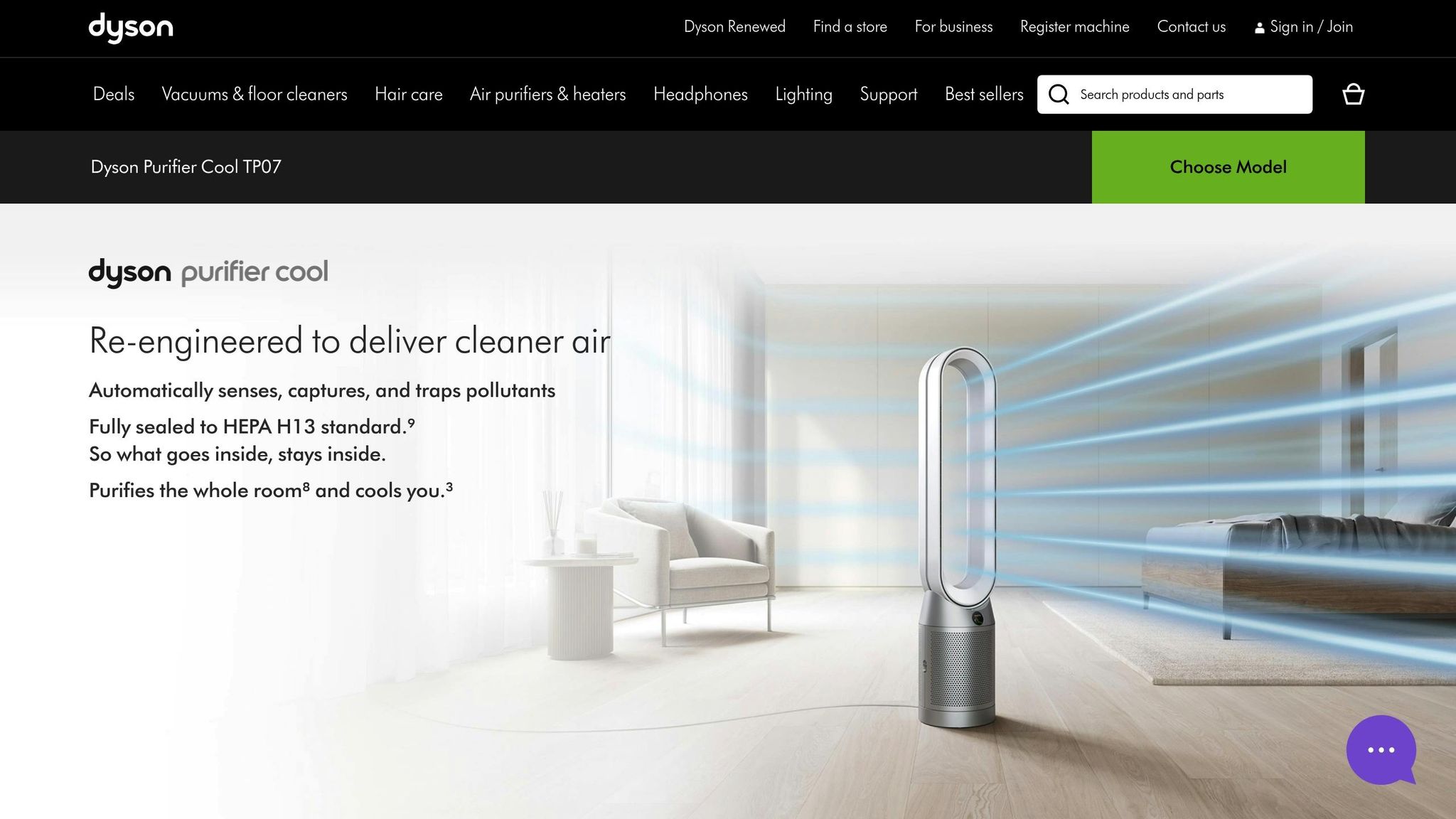
The Dyson Purifier Cool TP07 is a high-end device that combines air purification with cooling functionality. Priced at $429.99, it features advanced filtration technology and smart capabilities, making it a strong option for reducing airborne particles that can aggravate COPD symptoms. With a 4.2‑star rating from 757 Amazon reviews, users appreciate its ability to clean and monitor air quality, though some mention the noise level at higher speeds [38].
Room Size Compatibility
Designed for spaces up to 141 square feet with five air changes per hour, the TP07 is perfect for smaller areas like bedrooms or home offices. This focused approach makes it particularly effective for managing COPD symptoms in frequently used spaces. For example, placing the TP07 in a bedroom can help create a cleaner, more comfortable environment during the night.
CADR Ratings
The TP07 delivers consistent air cleaning performance, with CADR ratings identical to the older TP04 model:
| Pollutant | CADR Rating (CFM) |
|---|---|
| Smoke | 80.7 |
| Dust | 89.8 |
| Pollen | 95.9 |
These ratings highlight its reliability in removing common pollutants [37].
"The Dyson Purifier Cool TP07 is the best fan and air purifier combo on the market. Unfortunately, it disappoints as an air purifier alone as it has the same level of air cleaning power as a $99 air cleaner but it costs a lot more ($649.99)."
- Danny Ashton, HouseFresh Founder & Senior Writer [37]
Filter Types
The TP07 uses a two-stage filtration system, combining a 360-degree H13 HEPA filter and an activated carbon filter. The HEPA filter captures 99.97% of particles as small as 0.3 microns, while the activated carbon filter effectively removes gases, odors, and VOCs. This setup ensures comprehensive air cleaning. Filters should be replaced annually, with replacements costing $79.99 [39].
Noise Level
Noise levels range from 38.9 dB on the lowest setting to 56 dB on higher speeds. For quieter environments, such as spaces where COPD patients rest, the lower settings are ideal [37].
"Dyson does what Dyson does, and the TP07 shows major improvements in air cleaning performance and fan speed compared to earlier models. It is a high‑priced device, considering its air cleaning capabilities when compared to other cheaper air cleaners. But if you need a fan AND an air purifier with best‑in‑class smart features, then the Dyson TP07 is worth considering."
- Danny Ashton, HouseFresh Founder & Senior Writer [37]
6. Blueair Blue Pure 211+
The Blueair Blue Pure 211+ is a high-performance air purifier designed to handle large spaces, making it a strong choice for individuals with COPD who need consistent air cleaning. This Swedish-made unit has earned a 4.5-star rating from over 13,677 reviews on Amazon, reflecting its popularity and effectiveness [40]. Let’s take a closer look at its room coverage, CADR performance, and filtration system.
Room Size Compatibility
The Blue Pure 211+ is built for large and open spaces, efficiently cleaning rooms up to 540 square feet. It completes a full filtration cycle in such a room in just 12.5 minutes, achieving 4.8 air changes per hour [40]. For even larger areas, it can clean spaces up to 2,592 square feet within an hour [40]. This makes it a practical solution for COPD patients who spend time in expansive living rooms, open-plan kitchens, or spacious bedrooms where maintaining clean air is essential.
CADR Ratings
This air purifier doesn’t just cover large spaces - it also delivers impressive Clean Air Delivery Rate (CADR) scores:
| Pollutant | CADR Rating (CFM) |
|---|---|
| Smoke | 350 |
| Dust | 350 |
| Pollen | 350 |
These ratings are verified [40], and real-world tests back up its performance. In a 320-square-foot room, the Blue Pure 211+ improved air quality by 96% within an hour. In a 560-square-foot space, it achieved a 92% improvement in the same time frame [41]. During smoke removal tests, it cleared smoke from a glass box in just 11 seconds, showcasing its speed and efficiency [41].
Filter Types
The Blue Pure 211+ uses a robust 3-stage filtration system to tackle both particulate and gaseous pollutants, which is crucial for managing COPD symptoms. Here's how it works:
- Washable Fabric Pre-Filter: Captures larger particles like pet hair and dust, extending the life of the main filter.
- Combination Particle and Carbon Filter: The particle filter captures airborne particles as small as 0.1 micron, including pollen, mold, pet dander, bacteria, viruses, and dust [42]. The carbon filter absorbs odors, smoke, chemicals, and VOCs [42].
The combination filter typically lasts 6–12 months, with replacements costing around $60. The washable pre-filter can be cleaned regularly to maximize the life of the main filter [42][43].
"Original filter works well in the air purifier. They last about six months in my machines before they need to be replaced." - jcgeesick [42]
The unit also features HEPASilent technology, which combines mechanical and electrostatic filtration. This allows it to capture ultra-fine particles that standard HEPA filters may miss [41].
In June 2025, an Amazon customer named Ishmam shared their experience, saying the purifier "removes vape smoke at level 2 and 3 very well" and "seems to help with nasal congestion and smell removal." They also highlighted the effectiveness of the auto mode in detecting and eliminating airborne pollutants [40].
The Blue Pure 211+ is a solid choice for anyone seeking reliable air purification in larger spaces, especially those managing respiratory conditions like COPD. Its combination of extensive coverage, strong CADR ratings, and advanced filtration technology make it a valuable tool for improving indoor air quality.
7. Medify MA-40
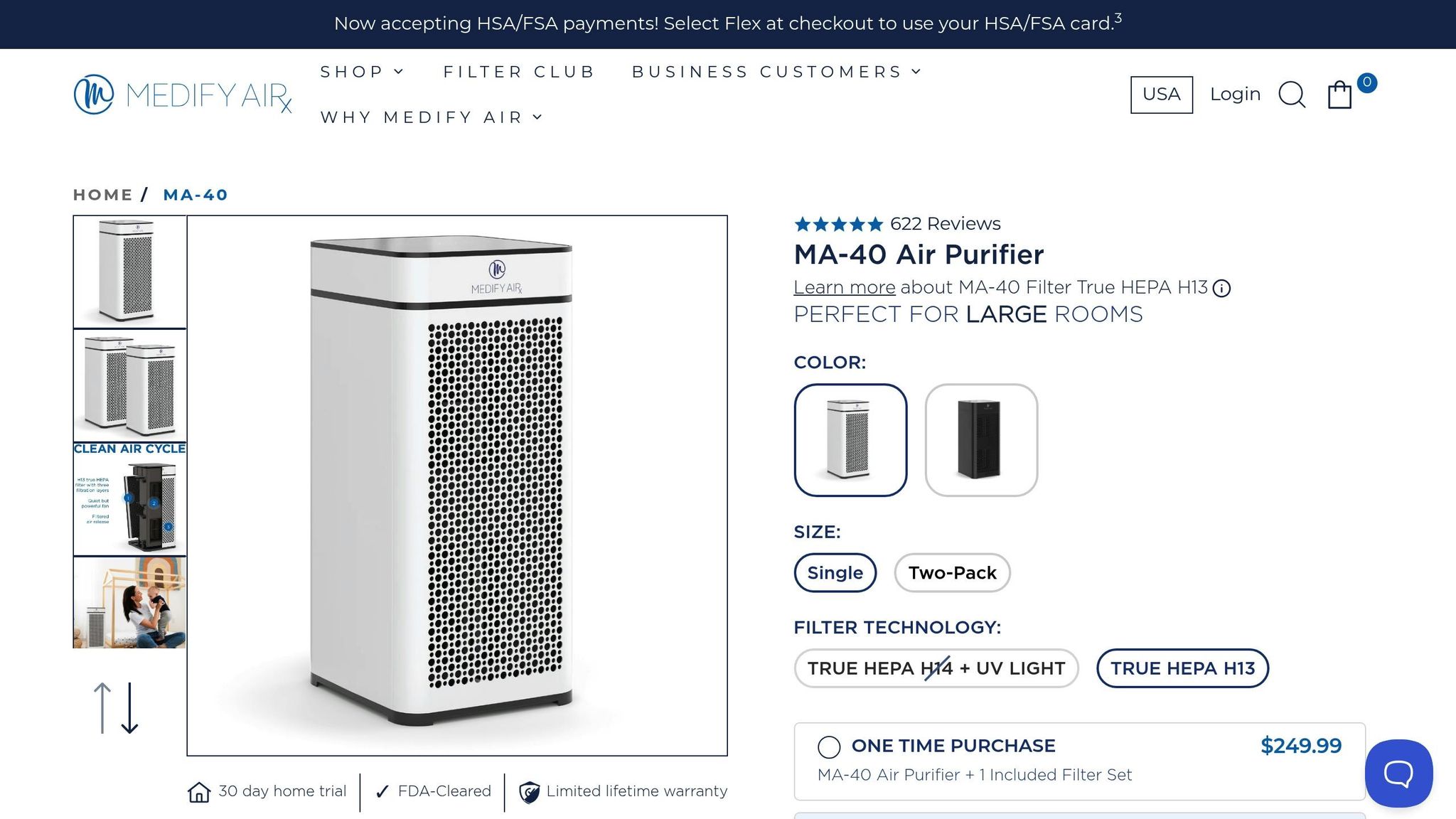
The Medify MA-40 stands out as a dependable air purifier, particularly for individuals managing COPD. With a solid 4.8-star rating from 622 reviews [44], this model offers excellent room coverage, strong CADR ratings, and a three-layer filtration system that effectively tackles airborne pollutants. Let’s break down why the MA-40 is a smart option for improving air quality.
Room Size Compatibility
The MA-40 is designed to handle medium to large spaces, cleaning up to 896 square feet in just 30 minutes [44]. This quick air turnover ensures that allergens and irritants don’t linger, making it ideal for living rooms, bedrooms, or home offices.
CADR Ratings
This purifier delivers consistent performance across key pollutant categories:
| Pollutant | CADR Rating (CFM) |
|---|---|
| Smoke | 239 |
| Dust | 231 |
| Pollen | 240 |
These CADR ratings highlight its ability to remove common COPD triggers. The 239 CFM smoke rating is particularly useful for tackling cooking fumes, wildfire smoke, or secondhand smoke, while the dust and pollen ratings ensure effective removal of fine particulates and allergens [44].
Three-Layer Filtration System
The MA-40 employs a robust filtration system with an airtight seal to ensure pollutants don’t bypass the filters:
- Pre-Filter: Captures larger particles like pet hair, fibers, and dander before they reach the main filter [44].
- True HEPA H13 Filter: Removes 99.97% of airborne particles measuring 0.1 to 0.3 microns [44][45]. This medical-grade filter is effective against bacteria, viruses, fine dust, and tiny allergens.
- Activated Carbon Filter: Absorbs odors and smoke that can irritate sensitive airways [44].
The filters last approximately 3,000 hours (4–5 months) [44], making maintenance straightforward and cost-effective.
With its combination of efficient filtration, broad room coverage, and ease of use, the Medify MA-40 offers a reliable solution for COPD patients who need cleaner air in medium to large spaces.
8. Rabbit Air MinusA2
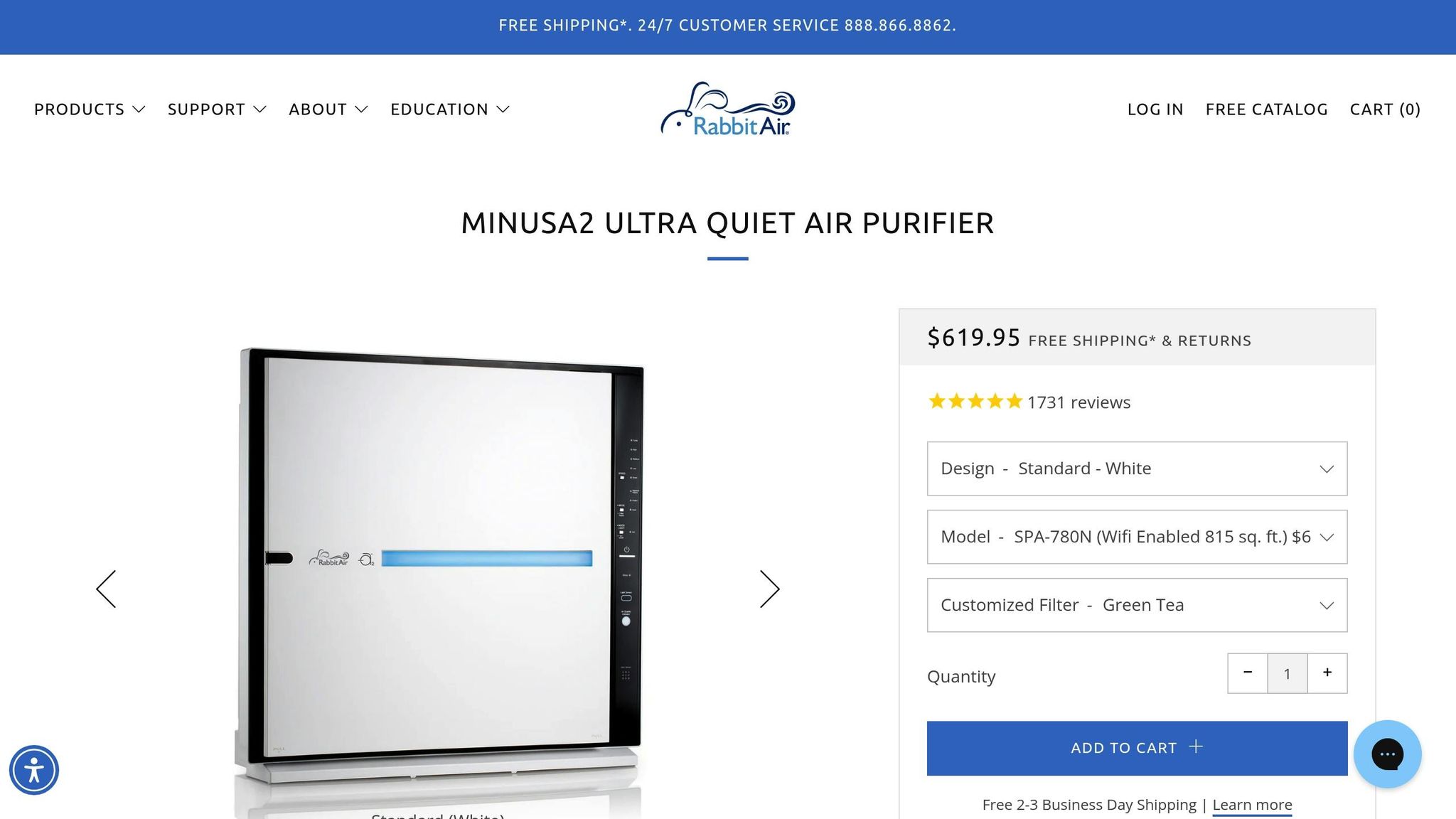
The Rabbit Air MinusA2 offers a sleek, wall-mountable design paired with comprehensive filtration, making it a practical choice for COPD patients who want cleaner air without cluttering their floors. With a 4.7-star rating from 2,455 Amazon reviews [47], this purifier is praised for its customizable filters and whisper-quiet operation. Starting at $619.95 [47][49], it’s a premium option for improving indoor air quality.
Room Size Compatibility
The MinusA2 is designed to handle rooms up to 815 square feet with two air changes per hour or 408 square feet for four air changes per hour [46][49]. The higher air change rate ensures quicker removal of irritants and pollutants, making it ideal for COPD management.
One reviewer noted its effectiveness in a 500-square-foot office for reducing tobacco pipe smoke [46], while another highlighted its performance in living spaces up to 270 square feet [48]. For larger areas, additional units may be necessary to ensure thorough air cleaning [50]. This flexibility allows users to tailor the purifier’s coverage to their specific needs.
CADR Ratings
The MinusA2 delivers strong Clean Air Delivery Rate (CADR) performance across three major pollutant categories:
| Pollutant | CADR Rating (CFM) |
|---|---|
| Pollen | 200 |
| Dust | 193 |
| Smoke | 180 |
The 200 CFM pollen rating is especially useful for tackling seasonal allergens that may aggravate COPD symptoms. Meanwhile, the 180 CFM smoke rating helps manage cooking fumes and other airborne irritants [47]. These ratings adhere to AHAM standards, which suggest the smoke CADR should be at least two-thirds of a room’s floor area [51].
Filter Types
The MinusA2 employs a six-stage filtration system to provide thorough air cleaning. Its BioGS HEPA filter captures 99.97% of particles as small as 0.3 microns [47], effectively trapping bacteria, mold, pet dander, and fine dust that can irritate sensitive airways.
Users can customize the filtration system with options like Germ Defense, Toxin Absorber, Pet Allergy, or Odor Remover filters, tailoring the purifier to their specific needs [47][48]. An activated carbon filter further reduces volatile organic compounds (VOCs) and household odors that may trigger respiratory symptoms [47].
The BioGS HEPA filter goes beyond standard HEPA filters by inhibiting the growth of bacteria and viruses on its surface [47], offering an added layer of protection for COPD patients who are more vulnerable to respiratory infections.
Noise Level
Operating at 25.6–51.3 dBA, the MinusA2 runs quietly enough for bedrooms and other quiet spaces [47]. It also features a light sensor that automatically shifts the unit into sleep mode in dark environments, ensuring restful nights without disruption [47].
"The wall-mountable Rabbit Air MinusA2 may have a complex setup, but it delivers exceptional performance." - Danny Ashton, HouseFresh Founder & Senior Writer [48]
Certified asthma and allergy friendly by the Asthma and Allergy Foundation of America (AAFA) [52], the MinusA2 is a dependable choice for those managing respiratory conditions who need consistent, quiet air purification.
9. Alen BreatheSmart 75i
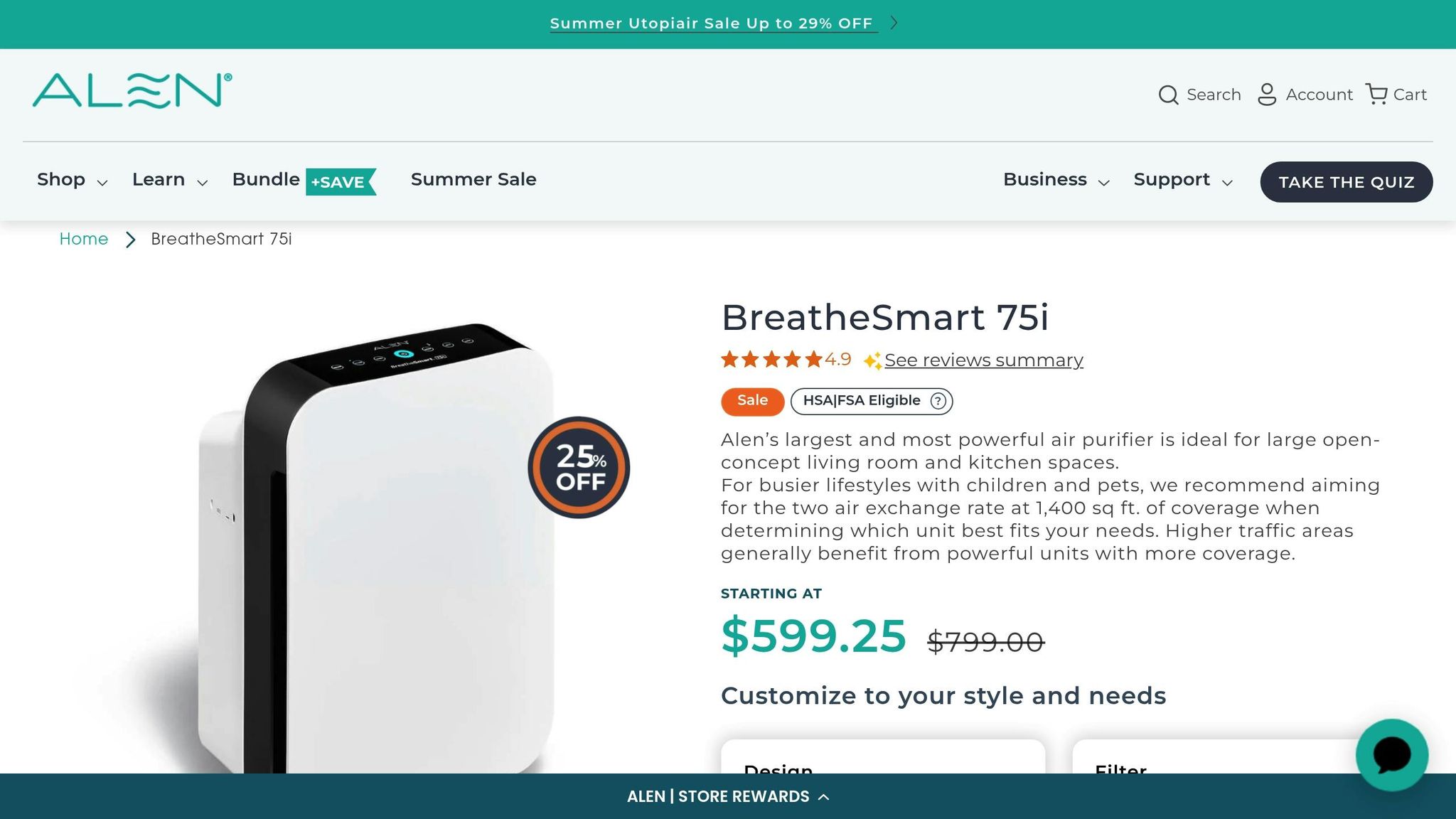
The Alen BreatheSmart 75i is a top-tier air purifier designed for large spaces and open-concept areas, perfect for individuals with COPD who require thorough air cleaning. With an impressive 4.9 out of 5-star rating [53] and a highly rated score from Consumer Reports [54], this purifier delivers exceptional performance. Currently priced at $599.25 (down from $799.00) [53], it offers professional-grade air purification at a more accessible cost.
Room Size Compatibility
This powerhouse purifier can clean up to 2,800 sq ft in an hour, providing two complete air changes per hour for spaces up to 1,400 sq ft. Whether it's a large living room or an open-concept home, the BreatheSmart 75i ensures consistent air quality where it matters most. Its ability to cover substantial areas means fewer units are needed throughout the home, making it a practical solution for maintaining clean air in larger spaces.
Filter Options
The BreatheSmart 75i is equipped with medical-grade H13 True HEPA filters, capable of capturing 99.99% of particles as small as 0.1 microns. Users can choose from three specialized filters:
- Pure: Targets allergens.
- Fresh: Designed for smoke and chemicals.
- Odor: Neutralizes unpleasant smells.
Each filter costs $99 and lasts 10–12 months, with built-in RFID technology to alert users when it's time for a replacement [53]. Studies back the health benefits of advanced filtration like this. For example, research from Johns Hopkins University found that air purifier use improved heart rate variability in COPD patients by 25% [55]. Similarly, children with asthma saw a 24% reduction in airway resistance when air purifiers were used overnight [55].
Quiet Performance
Despite its powerful capabilities, the BreatheSmart 75i operates quietly, even on higher settings, making it ideal for nighttime use. Many users appreciate its noise levels, which allow for undisturbed sleep.
"We love both of them. We always know when or how pure our air is. It shows you by the color indicator. Very quiet." - Bridgette H., Verified Buyer [53]
The purifier also features smart sensors that detect pollutants and automatically adjust its performance to maintain optimal air quality. Its Auto Light Mode dims the control panel in low-light conditions, ensuring a restful environment for overnight use.
"This machine is AWESOME!! It definitely takes out all the smells in the house. It kicks right up to full speed when any food is cooked or essential oils are lit or diffused. I feel so much better with my allergies." - Davenna W., Verified Buyer [53]
With its extensive coverage, advanced filtration, and quiet operation, the Alen BreatheSmart 75i is an excellent choice for those with COPD looking to improve air quality throughout their home.
10. GermGuardian AC9200WCA
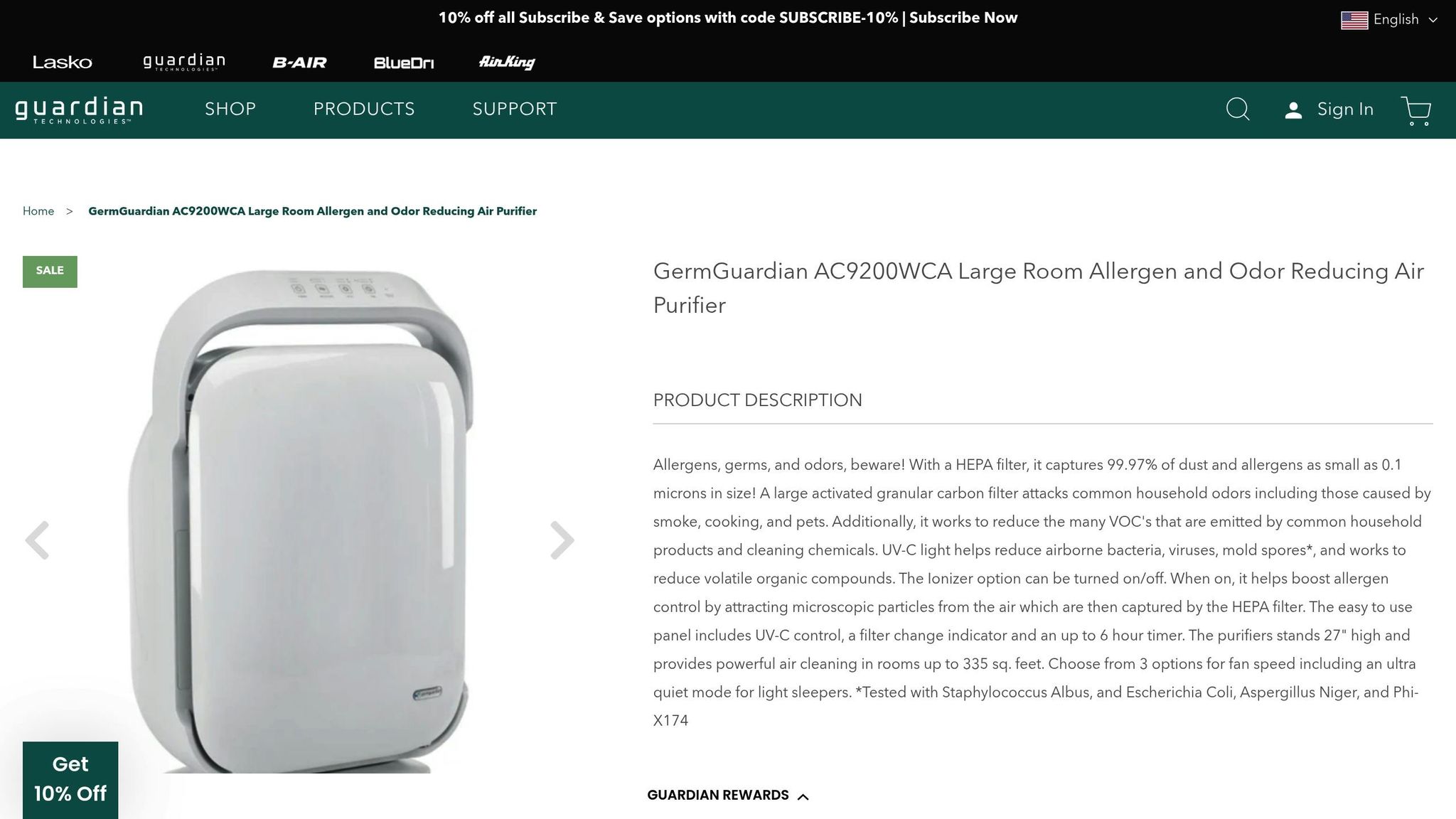
The GermGuardian AC9200WCA wraps up our top 10 list with strong performance tailored for large spaces. Garnering a 4.5-star rating from 353 Amazon reviews [58], this model uses a three-stage filtration system to tackle various air quality challenges that may worsen COPD symptoms.
Room Size Compatibility
Built for larger areas, the AC9200WCA fits perfectly in spacious living rooms, master bedrooms, or open-concept layouts. It circulates air 4.8 times per hour in a 335 sq. ft. room [56] and performs one full air change per hour in spaces as large as 1,620 sq. ft. [56]. This high circulation rate helps maintain cleaner air by reducing pollutant levels effectively.
CADR Ratings
The unit delivers impressive CADR ratings: 244 for smoke, 310 for dust, and 346 for pollen [57]. These ratings highlight its ability to remove particles that can trigger COPD symptoms, particularly during allergy-prone seasons. Such performance is made possible by its advanced filtration system.
Filtration System
The AC9200WCA features a three-stage filtration system designed to tackle a variety of pollutants:
- HEPA Filter: Captures 99.97% of dust, allergens, and other fine particles [56].
- Activated Carbon Filter: Targets odors and volatile organic compounds (VOCs) [56][59].
- UV-C Light Technology: Helps reduce airborne bacteria, viruses, and mold spores [56].
Additionally, the unit includes an optional ionizer to further enhance allergen control [56].
Noise Level
On lower settings, the AC9200WCA operates quietly [56][60], making it a good fit for bedrooms where peace and quiet are essential. However, some users have noted that the LED panel lights cannot be turned off, which could be an issue in dark environments [58].
One reviewer praised its performance in an 850 sq. ft. apartment, noting better filtration and odor control [58]. Another user reported experiencing fewer allergy symptoms and fresher air in a large bedroom [58].
While replacement filters can be costly over time [58], the GermGuardian AC9200WCA remains a reliable choice for COPD patients looking for effective air purification in larger spaces.
Air Purifier Comparison Chart
Here’s a handy chart that lays out the key specs of popular HEPA air purifiers. It highlights room size coverage, CADR ratings, filter types, noise levels, pricing, and standout features. Use this as a quick reference to find the purifier that suits your needs best.
| Model | Room Size Coverage | CADR Ratings (CFM) | Filter Types | Noise Level | Price Range | Key Features |
|---|---|---|---|---|---|---|
| Levoit Core 400S | Up to 403 sq. ft. | Dust: 260, Pollen: 260, Smoke: 230 | HEPA + Activated Carbon | 24-50 dB | $200-$250 | Smart app control, air quality monitoring |
| Honeywell HPA300 | Up to 465 sq. ft. | Dust: 300, Pollen: 300, Smoke: 300 | True HEPA + Activated Carbon | 50-60 dB | $200-$300 | Turbo clean setting, AHAM certified |
| Coway Airmega 400 | Up to 1,560 sq. ft. | Dust: 350, Pollen: 400, Smoke: 400 | Dual HEPA + Activated Carbon | 22-52 dB | $400-$500 | Dual suction, real-time air quality indicator |
| Winix 5500-2 | Up to 360 sq. ft. | Dust: 243, Pollen: 246, Smoke: 232 | HEPA + Activated Carbon + PlasmaWave | 27-54 dB | $200-$230 | PlasmaWave tech, sleep mode |
| Dyson Purifier Cool TP07 | Up to 141 sq. ft. | Overall: 94 | HEPA + Activated Carbon | 40-64 dB | $500-$600 | Cooling fan, 360° filtration, app control |
| Blueair Blue Pure 211+ | Up to 540 sq. ft. | Dust: 350, Pollen: 400, Smoke: 350 | HEPA + Activated Carbon | 31-56 dB | $300-$350 | Washable pre-filter, energy efficient |
| Medify MA-40 | Up to 840 sq. ft. | Dust: 330, Pollen: 380, Smoke: 360 | H13 Medical Grade HEPA + Carbon | 35-66 dB | $300-$400 | Medical-grade H13 filter, touch panel |
| Rabbit Air MinusA2 | Up to 815 sq. ft. | Dust: 200, Pollen: 200, Smoke: 193 | HEPA + Activated Carbon + Customizable | 25-45 dB | $500-$700 | Wall-mountable, customizable filters |
| Alen BreatheSmart 75i | Up to 1,300 sq. ft. | Dust: 347, Pollen: 373, Smoke: 284 | HEPA + Activated Carbon | 39-55 dB | $600-$800 | Smart sensors, lifetime warranty |
| GermGuardian AC9200WCA | Up to 1,620 sq. ft. | Dust: 310, Pollen: 346, Smoke: 244 | HEPA + Carbon + UV-C Light | 40-60 dB | $200-$300 | UV-C sanitization, large room coverage |
Understanding the Numbers
When it comes to CADR (Clean Air Delivery Rate), higher numbers mean faster air purification. For managing COPD, H13 medical-grade HEPA filters are particularly effective, capturing 99.97% of particles as small as 0.3 microns. These results are backed by AHAM testing [62].
Matching Room Size
The purifier’s capacity should align with your room size. To maintain clean air, aim for at least four air changes per hour. In larger spaces, using multiple smaller units can sometimes be more effective than relying on a single high-CADR purifier [61].
Balancing Cost and Efficiency
The models listed range from $200 to $800. While upfront cost is important, don’t forget to factor in ongoing filter replacement expenses. Some models, like those with washable pre-filters, can reduce long-term maintenance costs, making them a smart choice for ongoing COPD management.
Conclusion
Finding the right HEPA air purifier for managing COPD isn't about picking the priciest option or the one with the best reviews. It's about choosing a model that fits your living space and meets your specific breathing needs. One key factor is ensuring the purifier's performance matches the size of your room, as this directly impacts its ability to work effectively [6].
When the sizing is spot on, the benefits can be impressive. Research by Hansel et al. [10] showed that former smokers with COPD who used active air cleaners saw a 61% greater reduction in indoor PM2.5 levels and a 24% drop in NO₂ concentrations over six months compared to those using sham cleaners. These improvements translated into meaningful health outcomes, such as fewer moderate exacerbations, reduced respiratory symptoms, and less reliance on rescue medications. This underscores how crucial it is to choose an air purifier with the right capacity for your space.
HEPA filters are designed to remove 99.97% of airborne particles, including pollutants like PM2.5, smog, and bacteria larger than 0.3 μm. However, this level of performance depends on matching the purifier to the air volume of your room [9].
Whether you're considering the affordable Winix 5500-2 for a smaller area or the Coway Airmega 400 for a larger space, the key is making a well-informed decision. Review the comparison chart above to evaluate which model suits your needs. Take into account your room's square footage and ceiling height, and select a purifier with the right capacity to ensure effective air cleaning without wasting resources on a mismatched unit.
FAQs
To figure out the right CADR (Clean Air Delivery Rate) for your room, start by calculating the room’s volume in cubic feet (length × width × height). Then, multiply that number by 0.67 to get the minimum CADR rating needed for effective air purification. For instance, if your room measures 12 ft × 10 ft with an 8 ft ceiling, the calculation would look like this: 12 × 10 × 8 × 0.67, resulting in a minimum CADR of 642. This ensures the air purifier can handle the space effectively, promoting better respiratory health.
True HEPA filters are engineered to capture 99.97% of airborne particles as tiny as 0.3 microns. This includes common irritants like dust, pollen, pet dander, and other pollutants that can trigger COPD symptoms. By delivering such a high level of filtration, these filters help create cleaner indoor air - a critical factor for individuals with sensitive respiratory systems.
In contrast, standard or HEPA-like filters often fall short when it comes to trapping smaller particles, leaving harmful irritants in the air. For those managing COPD, True HEPA filters play a crucial role in reducing exposure to allergens and pollutants, helping to ease breathing and lower the risk of flare-ups.
In large spaces, relying on multiple air purifiers can often work better than using a single unit with a high CADR (Clean Air Delivery Rate) rating. This approach is particularly useful in rooms with poor airflow or an awkward layout, as it allows for better overall coverage and circulation.
A single high-CADR purifier might have trouble cleaning the air evenly in a space with obstacles like walls or furniture. By strategically placing several smaller units, you can achieve more consistent air purification throughout the area, leading to improved indoor air quality and better support for respiratory health.
